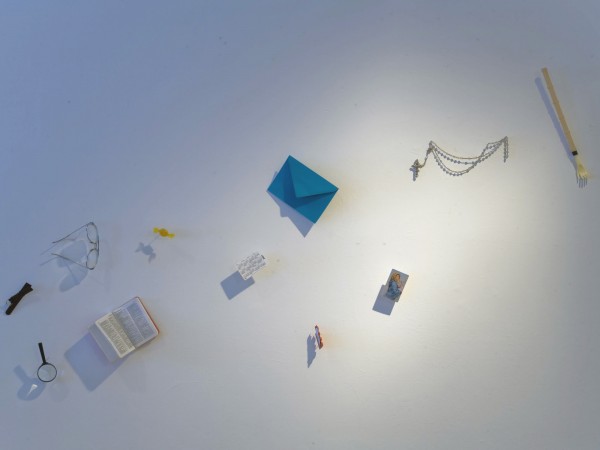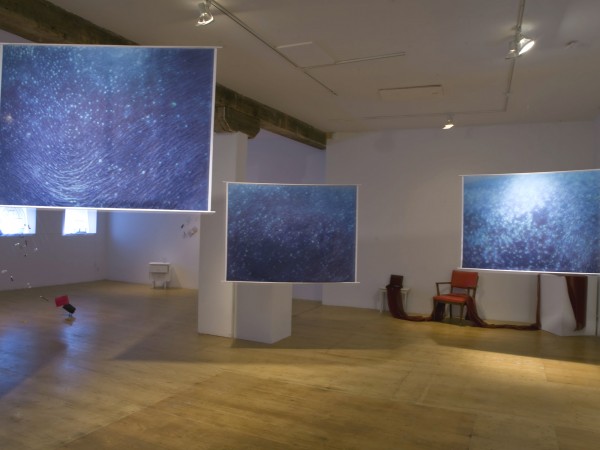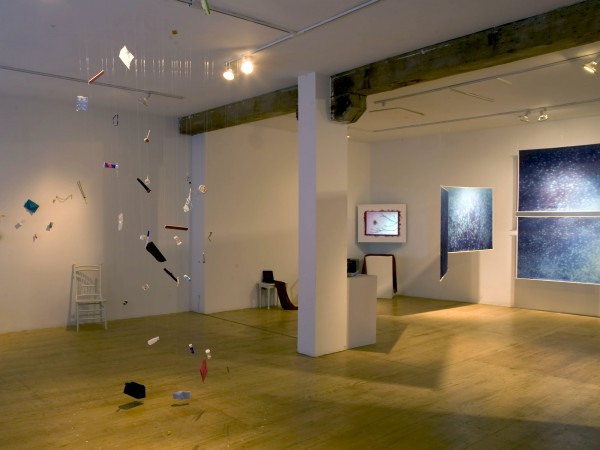Universos relativos: the final voyage, in three movements
par Jean-Pierre Guay
Gabriela Garcia-Luna
from November 12 to December 16, 2007
“We must bear witness to our great loss.”1
Shortly before commencing her residency at LA CHAMBRE BLANCHE, Gabriela Garcia-Luna lost her father, a doctor, to an incurable illness. The artist’s project Universos relativos drew on her experience of seeing her father, for the first time in her life, as a weakened and vulnerable man. Such was Garcia-Luna’s journey in this work. Universos relativos was first presented as a photographic exhibition in Mexico City in 2006, whilst her father was still alive, and subsequently as an installation at LA CHAMBRE BLANCHE at the end of 2007. Faced with the inevitable death of her father, the artist began a creative project focusing on time and memory. As the philosopher Alexis Klimov writes, “To create, is to go through the experience of death.”2
Writing about her project, Gabriela Garcia-Luna explains that, “To deal with my experience of life moving on, whilst the feeling of an unexplainable loss remains, I have begun to explore time as a concept, as a means of investigating other codes and changes in our experience and memory, reflecting on the still-thereness of his presence and the absence to come.”3
“Universos relativos seeks to create the memory of an experience lived by the artist at her father’s bedside…During her residency, Gabriela Garcia-Luna sought to illuminate three movements of time: that of existence (cut short in her father’s case) ; sensory time (in which experience and sensations are intensified by an awareness of the time of existence); and conceptual time (alternative, vast and timeless, traced in the movement of our thoughts).”4
Blue: the time of existence
Upon entering the exhibition space, the viewer was struck by the color blue, an effect arising from the presence of nine large-format photographs, three of which were suspended in front of us, with other six arranged in pairs on the wall to our right.
Once this initial impression subsides, we notice a text to our left, printed on the wall, at the foot of which is stood an atlas, its pages open at a map of the sky. The text is taken from L’Atlas de notre temps, and notably explains that, “All of these stars travel together through space, forming a wandering family or a group of suns, which in all likelihood share the same origins.”5 The images that we see in the space are scaled-up negatives of photographs that the artist has taken of numerous small red spots on her father’s skin, symptoms of his terminal illness. Garcia-Luna had no choice from there on in, other than to find a new universe of meaning to accept fatality. She not only transformed these tiny points into a metaphor for the immensity of the universe, but also the relative importance of life. Incidentally, the blue that was revealed in the negatives is also the symbol for infinity, from which all life comes. Beyond the zone of blue in the space, we notice an area dominated by red.
Red : sensory time
A long piece of red fabric links together a series of objects that evoke what we imagine of her father’s life, but also the hope that time may be suspended, settled, faced with the uncertainty of illness. A red armchair is positioned in the center of the space, to the left of which there is a small bedside table, and to the right of which we see a screen on a plinth, covered with the same red fabric.
The artist has opened a small travel chest on the bedside table, which contains three letters : they contain stories of three journeys, which her father has recounted to her mother. One of the letters discusses faraway travels to a Mexico crippled by poverty. Left unfinished, the letter aroused much emotion in the artist. Once again, time is suspended in order to cope with uncertainty. That said, time refuses to stand still.
An apparently-fixed image appears on the screen, showing the branches of a tree. At the end of one branch we see a single maple leap, clinging persistently. It too is red. The leaf trembles in the wind, then suddenly, in an instant, it gives way, falls loose, and is carried off. The image changes, and we see a mechanical shovel that, in one fail swoop, shatters the bedside table: rupture, loss, death.
Only a handful of people were witness to a key intervention by the artist, the evening prior to her departure. Her decision to paint the whole wall in this area of the space red further heightened the emotive charge of the space. In contrast to the blue section of space that comes before it as we enter, the effect was gripping.
White : conceptual time
This area of the exhibition space focused on the duality of presence and absence in suspended time. A white chair was indicative of this reality, inviting us to sit and let our thoughts wander, inspired by the objects suspended around us.
Placed at an angle with the wall, a small white bedside table, with an open drawer, evoked the table depicted in the video. On the adjacent wall, a series of heterogenous objects were arranged as though they had spurted out of the draw and flown across the space. As with the other items in the space, these objects evoked the life of her father and different aspects of his personality, and spoke of the relationship between the past and the contents of memory. Objects suspended in the center of the space – which seemed to move as a whole towards the ceiling – symbolized flight. This movement was accentuated by the use of translucent cord, creating the effect of luminous rays.
On the main wall, Garcia-Luna had transformed four window spaces into luminous alcoves. A birdcage was positioned within each of these recesses, illustrating the duality of presence and absence. In many traditions, the soul’s departure from the body is symbolized by a bird. In an interview at LA CHAMBRE BLANCHE6 the artist added that her father adored birds.
The installation was accompanied by two soundscapes. The first was created specially for the exhibition by the Mexican artist Diana Andueza. The second, created by Garcia-Luna herself, played in the four corners of the space, and featured the sound of drops of blood as they fell, symbolically, to the floor. The combination of these two soundscapes evoked the body and the soul of now-departed father.
In an interview broadcast on the CKRL radio station7 in Quebec City, Gabriela Garcia-Luna explained that she had worked with the public for the first time during this project. The artist drew up a list of 57 objects, with items ranging from a case for spectacles and a Bic biro, to a set of rosary beads and a caramel sweet. From there, the artist called on ten or so people with whom she formed friendships during her residency to participate in a ritual of sharing and exchange.
The final journey
It is often said that death is the final journey. Gabriela Garcia-Luna’s installation echoed this saying. The notion of the journey was present in the three areas of exhibition space: from the blue of traveling stars, to the red of the chest and the travel letters, to the white of the concluding space, and a video based on the artist’s car journeys with her father. It was as though, carried off by poetry, the human journey is never ending.
Poetry inspires poetry. That of Roland Giguère evokes the memory of Universos Relativos, an installation by Gabriela Garcia-Luna that so eloquently expressed the universality and fragility of life.
“I also know a bleeding star
in its blue vice
whose painful reflection dazzles me
with the dying of each day”8
- Beausoleil, Claude, ″Le Grand Hôtel des Étrangers″ in Graveline, Pierre. 2007, ″Les cents plus beaux poèmes québécois″. Montreal: Fides editions, p.24.
- Klimov, Alexis. 1985, ″De l’abîme″. Quebec: Du Beffroi editions, p. 42.
- Gabriela Garcia-Luna, ″Constellations/ blue″, project dossier accompanying ″Universos relativos″, Mexico, 2005.
- Lévesque, Maude. 2007, ″Universos relativos″, Press release, Québec: LA CHAMBRE BLANCHE.
- Debenham, Frank. 1964, ″L’Atlas de notre temps: Du centre de la Terre aux limites lointaines de l’espace″. Spanish edition prepared by Francisco Vázquez Maure, Madrid: Sélection Reader’s Digest editions, p.118.
- LA CHAMBRE BLANCHE [online]. http://www.chambreblanche.qc.ca/EN/event_detail.asp?cleLangue=2&cleProgType=1&cleProg=1734051703&CurrentPer=File (consulted on december 16, 2007).
- CKRL, Interview at Aérospatial with Jean-Pierre Guay and Richard Ste-Marie [online].
http://www.richardstemarie.net/radiomemoire.org/artsvisuels/Gabriella_Garcia_Luna.html (broadcast on december 5, 2007). - Giguère, Roland. 1988, ″Forêt vierge folle″. Montréal: Typo Poésie editions, p. 118.


